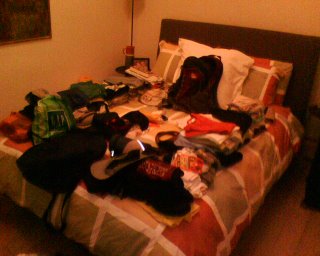Is Creationism Selling God Short?
I've been seeing and reading a lot about Creationism lately. This includes the battle in Dover, PA to teach Creationsism, or rather "Intelligent Design" in school and the new natural history museum based on Creationism's re-interpreted timeline of the World.
The Dover Case is an interesting story in and of itself. There is a key issue that came up in the case that got me thinking that maybe the Creationists are selling God short. The Creationist's case for intellligent design is summed up by the statement that evolution is just a theory and there are enough gaps in the theory to warrant the consideration of other theories (namely Creationism). Of course their argument starts with a misinterpretation of what science means by "theory". But there are gaps in the fossil record and the Creationists have used these to drive their case. One of these gaps was the missing link between fish with scales and land-dwelling reptiles. If reptiles evolved from water-dwelling fish, there should be animals in the fossil record that have overlapping features. For some time, scientists had been unable to find evidence of these animals and during this time, creationists used that missing link as an example when promoting their case. But then fossils of a cross-over animal were found... a reptile with legs and fish-like scales.
Each time evolution science makes a discovery relating to what intelligent design saw as a flaw, it forces the Creationists to re-work their case. None of their arguments for intelligent design have been accepted by mainstream scientific journals. They convert the largely converted of their case almost entirely by pointing to what the bible says about the evolution of life and by pointing to perceived gaps in the prevailing scientific view.
Their self-imposed behavior of re-adjusting their argument each time their previous one is debunked got me thinking. If God is all knowing and almighty why would he spend so much time figuring out how to make an eyball, or a reptile, or monkeys that are so similar and yet evolutionarily separate from humans. Why wouldn't God, as the smartest of smarts, take a smarter approach.
It seems to me that if I were God and I was planning the creation of the universe that my time would be better spent setting certain rules in motion rather than trying to create each atom, organ, and animal individually. Maybe God has much more to worry about than just our own little planet in this little Milky Way Galaxy. Maybe there are even other universes to worry about and maybe he has tried working with different rules in thos universes. If that were true, it would be almost foolish, if not stupid, for God to put so much time into the creation of individual organisms.
It seems to me that the history of man, religion and cosmology is about moving up the food-chain of creation. For cavemen, everything was the work of God... fire, the birth of another person, etc. For the Greeks, it seems the stars were the outlines of gods in the night sky. For aboriginal cultures, the Earth is like the Mother God... the one resposnible for creating all the things we enjoy on Earth.
These myths serve their purposes and help make sense of a mysterious world. The aboriginal culture myths create a culture that is more environmentally friendly than many enlightened environmentalists are today. But even as we still regard the birth of a baby in the family as a "miracle", we also know how babies come to be. We understand the science and biology of reproduction and how it relates to reproduction in other species. When that mystery was solved, we moved onto the next mystery.
So it seems like you could have a belief in science and a belief in God and reconcile the two. All that is requires is a belief that science brings us new understandings of the world around us. Since science builds on previous discoveries, it also means that earlier generations did not know these things and did the best to explain the world around them in terms they understood at the time. This includes the story of the bible. Accepting science requires that you accept the stories of the bible as parables and interpretations of history and creation myths and not as hard facts that can not themsleves be interpreted in light of recent discoveries.
At some point in our human history, everything on Earth was magic and there was no science. Fire and lightening were God's work until we figured out how to make it ourselves. The discovery process continues until we find ourselves where we are today, contemplating the existence of other universes in theoretical physics. These theories are based on rules of science, mathematics and quantum mechanics. So if whole parallel universes are possible and contemplated by our smartest physicists, couldn't an almighty God work by implementing these rules. In this light, we are just slow, dumb organisms taking thousands of years to understand our immediate surroundings let alone the cosmos. If these parallel universes exist, God not only understands them but put the rules in motion while also thinking up the rules that would allow electrons to spin around a nucleus in such a way as to make carbon possible, so as to make organic matter possible and eventually, through the rules of electrical, chemical and physical interactions to make animals that would evolve into Adam & Eve and everything else on this
amazing planet. Isn't it possible? Isn't it amazing enough that whether or not some reptile with scales existed is such a minor issue relative to the grandeur of everything else. Wouldn't believing in all of this only make God more powerful and amazing?













.jpg)







